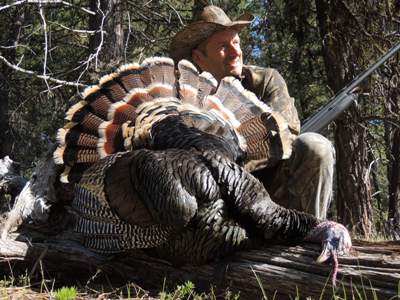Turkey Hunting East and West – By the Numbers
By Gary Lewis

According to the Department of Fish and Wildlife, turkey hunters tagged 4,132 toms in the 2011 spring season. And the top producer was the Melrose Unit with 563 birds and an average 2.7 days of hunter effort, .51 birds per hunter and .19 birds per hunter day.
With a harvest of 381, the White River Unit produced the next highest number of birds, but the birds-per-hunt-day ratio was lower at .06.
"Good turkey habitat produces the most birds. That's where I want to be when I have a turkey tag in my pocket." That's what I told Jeremy Johnson. Jeremy, a pro-staffer for BowTech Archery and a mechanic at Murray & Holt Motors in Bend, would hunt with a bow and I would carry a shotgun.
We set the alarm for 1:15 in the morning and pointed west to Douglas County and a hunt with Jeff Miller, of Field and Marsh Outfitters. It was windy and raining. I think if ODFW calculated rain out of the equation, our success rates would prove higher.
 Down in a valley on a grassy knob, Jeremy slid into a blind. Miller and I set the Double Bull blind up on a hill and turned our backs on it to set the decoys. A gust of wind tumbled the blind down into the poison oak and I had to chase it.
Down in a valley on a grassy knob, Jeremy slid into a blind. Miller and I set the Double Bull blind up on a hill and turned our backs on it to set the decoys. A gust of wind tumbled the blind down into the poison oak and I had to chase it.
For the next two days, we set up where turkeys were supposed to be, saw them elsewhere and stalked to close the gap to 60 yards but no closer. Every time the sun came out, so did the turkeys. Then the wind would blow a cloud over the sun and the rain drove them back into the trees.
On the way back to the dry side of the mountains, we stopped at the BowTech factory in Eugene and bought carp-fishing tackle. Two days later, we stalked the shoreline of a lake and Jeremy lanced two carp in three tries. I missed my only opportunity.
Licking my wounds, I looked eastward for another chance at a gobbler. Troy Rodakowski, a writer from Junction City, emailed to say he wanted to get back in the woods one more time. We elected to try a spot he knew high in the pine forest.
The mountains of the Ochoco are not turkey hunting Nirvana. In 2011, hunters tagged 69 gobblers with a scant .04 birds per hunt day. Still, a run-and-gun approach could pay off if we could luck into a lonely bird.
Rodakowski, running on three-hours of sleep and a Thermos of coffee, rolled into Bend at 3:45 in the morning and we were out of the truck and into the pines at 6:00.
No turkey sign. On foot, we followed old logging tracks up through the timber and heard a coyote howl from the opposite ridge. Troy answered back with a crow call and a gobbler shock-gobbled back. We were in business.
Below us was a creek and beyond that, a fence. We crossed the creek and set up at the fence line. Troy putted and purred with his mouth call and the turkey fired off, just above us behind a ridge of lava, a rolling gobble-obble-obble that rattled the branches. When next we heard him, he was on the ridge going away.
We followed our ridge downhill and crossed two more creeks, stopping to check the tom's temperature with hen talk from time to time. There were two gobblers and they were on the move. After 45 minutes of cat and mouse, we found ourselves just in front of them. I slid in next to a pine and Troy set up behind me.
A little hen talk fired up the closest gobbler again and that was when we heard the female, berating him. If momma isn't happy, no one is happy. She squawked and Troy purred and putted, coy, alluring.
I saw the gobbler's white head crest the top of the hill. He ran toward us, gobbling all the way then turned to strut as if to say, 'Ain't I the pretty one?' In range, he strutted and gobbled. My heart rate up, I had to pull my face mask off my nose to get a breath.

Focused now on that white/blue head and the red of his wattles, my Tru-Glo fiber-optic front sight covered him when he stepped into an opening.
We paced it off later – 23 yards. The gobbler's spurs would have measured an inch if they hadn't been rounded by running the lava. He weighed in at 16.1 pounds and his broomed-off beard measured 7.5 inches.
The season may be more than half over, but as the hens take to their nests, those gobblers are going to be lonely.
Going by the numbers, Oregon's best turkey habitat is in the southwest corner of the state. Over on the dry side, the White River, Ukiah, Murderer's Creek, Wenaha, Mt. Emily and Sled Springs produce the most gobblers. There is more than enough time on the calendar to make the odds work for you.


